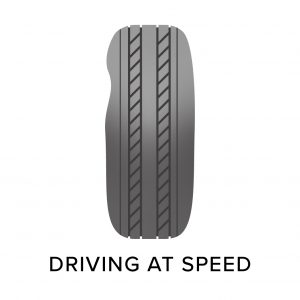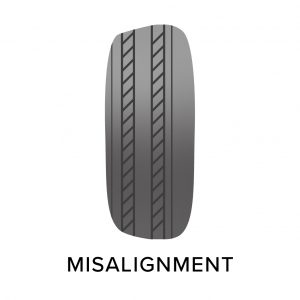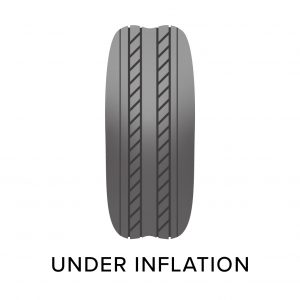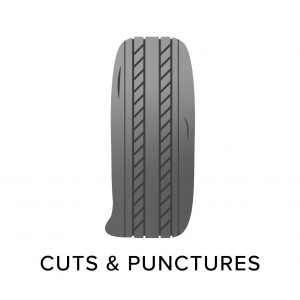The 8 Most Common Problems with Tyres
As the only point of contact your car has with the road, it is likely that the biggest cause of problems you experience with your vehicle will be due to your tyres. Knowing the signs of a problem with your tyres is important so that you can have them repaired or replaced as soon as a problem is identified, ensuring your car remains safe to drive at all times.
Our team here at Munster Tyres have put together a guide on the most common tyre problems a driver is likely to experience.
Over inflation 
Tyres that are over inflated will not perform safely. This is because the more that you inflate a tyre, the more difficult it is for them to maintain contact with the roa
d and allow the tread to establish grip. On top of this, the more pressure you fill the tyres with, the more stress you put the structure of the tyres under which, in turn, will shorten tyres’ lifespan.
One way to tell if you have an over inflated tyre is by looking at your tyres’ wear patterns. Are the centres of your tyres particularly worn down? If so, they probably need some air letting out.
Under inflation
Research suggests that around 60% of domestic vehicles on the roads in Europe have lower tyre pressures than recommended. If your tyres are under inflated, it can cause any or all of the following problems:
– An increased risk of understeer, which can lead to collisions
– Poor handling and difficulty performing precise manoeuvres
– More prone to general wear and tear
– An increased risk of punctures
If you are concerned about an under inflated tyre, you can monitor your tyre’s air pressure yourself, and inflate or deflate them accordingly.

Cracking and bulging
Cracks and bulges can appear in your tyres from hitting a pothole or kerb, the impact of which can cause cracks in the sidewall of the tyres. If your tyres are under or over inflated, this problem is more likely to occur and can only be fixed by replacing the tyres altogether. This might not necessarily be a bad thing though, as cracking can indicate that a tyre is getting into old age and needs to be replaced anyway.
Driving at speed 
If you are regularly driving at speed (for example, if you commute using the motorway), your tyres are at a higher risk of damage than if you were driving at lower speeds. Contact with road hazards such as potholes at high speeds can cause a higher degree of damage, whilst the overheating higher driving speeds create can cause tyre damage and a loss of control when driving.
If you notice any damage to your tyre after consistently driving at high speeds, you should replace your tyres immediately to ensure your safety when on the roads.
Misalignment 
If your tyre is worn more on one side than the other – something known as camber wear – it may be misaligned. Whether your vehicle hit a kerb, you adjusted the height of your vehicle or you’re experiencing general wear and tear, this is something that needs looking at. A misaligned tyre should be refitted or replaced depending on the severity of the wear, as it can reduce your tyre’s traction and grip on the roads if not fitted correctly.
Cuts and punctures
Puncture damage usually happens as the result of a particular road hazard, for example broken glass on the road. Consequently, this sort of damage is rarely the fault of the driver. However, you can certainly bolster your defenses against punctures by ensuring that your tyres are adequately inflated.
Emergency brake damage
The problem with emergency braking is that it can lead to almost instant tyre wear in a very specific area. Ultimately, this can lead to deflation and obscure vehicle handling if left for too long. So, if you have recently carried out an emergency stop, be sure to check your tyres for any localised wear.
Wear and tear
General wear and tear will happen with all tyres as they are used over time, but it’s important to monitor your tyres’ tread depth in order to ensure it is within the legal limit. If the tread depth is below 1.6mm, you cannot legally drive on the roads and must have your tyres replaced. It is worth noting, however, that this level of wear is the absolute minimum, and replacing your tyres before they reach this level will ensure your tyres are safe to be driven on the roads without sacrificing performance and grip.
If you think your tyres are in need of replacement, it’s important that your new tyres are fitted correctly and safely. We specialise in tyre fitting for vehicles of all makes and models here at Munster Tyres, ensuring your new set is safe for road use.
We also offer high quality, part worn tyres for those looking to replace their tyres on a budget – providing quality tyres at affordable prices, and without sacrificing your car’s road safety. For more information, or to book your car in with us today, simply contact the friendly team here at Munster Tyres and we’ll be happy to help.



